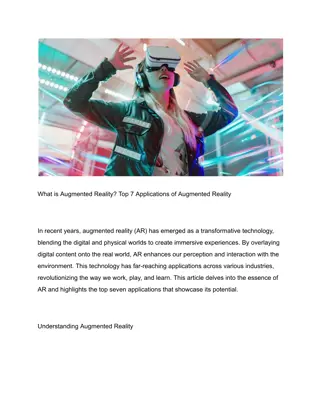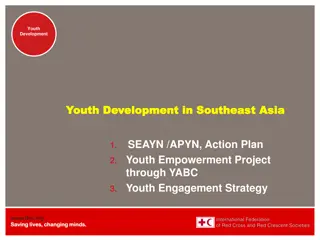Empowering Youth Offender Learning Through Augmented Reality
Augmented Reality (AR) is being utilized in a European Erasmus-funded project to enhance skills and reduce reoffending among young offenders. Led by Shrewsbury Colleges Group, the project aims to provide interactive learning experiences using AR technology, ultimately helping individuals lead law-abiding lives post-release. Education in prisons plays a crucial role in empowering offenders with skills, social capital, and well-being, contributing to their successful reintegration into society. Through the development of high-quality AR resources, the project aims to evaluate effectiveness, enhance learner experiences, and raise attainment in youth offender learning across different custodial establishments.
Download Presentation

Please find below an Image/Link to download the presentation.
The content on the website is provided AS IS for your information and personal use only. It may not be sold, licensed, or shared on other websites without obtaining consent from the author. Download presentation by click this link. If you encounter any issues during the download, it is possible that the publisher has removed the file from their server.
E N D
Presentation Transcript
Developing Augmented Reality in Youth Offender Learning ProjectOverview Overview Project 14 December 2021 14 December 2021 Richard Booth Richard Booth
Overview This dissemination event details the work of a European Erasmus funded project, over three years duration (2018-2021). The project; Developing Augmented Reality in Youth Offender Learning , is led by Shrewsbury Colleges Group (SCG) Project partners organisations from Romania, Belgium and UK: Biblioteca Judeteana Antim Ivireanu Valcea (BIB) Centrul Pentru Promovarea Invatarii Permanente Timisoara Asociatia (CPIP) Belgium European Humanity Center Brussels (EHCB) Her Majesty's Prison & Probation Service (HMPPS)
Project Summary Augmented Reality Augmented Reality (AR) can provide learners in offender learning with a more interactive way to develop and increase skills to help reduce reoffending and enable them to lead law abiding lives when released. Education should be Education should be at the heart (Dame Sally Coates) (Dame Sally Coates) at the heart of prisons of prisons
The purpose of education in prisons is to give individuals the skills they need to unlock their potential, gain employment and become assets to their communities. It should also build social capital and improve the well-being of prisoners during their sentences and once they are released back into society.
Project Aims Evaluate the effectiveness of using Augmented Reality resources for giving access to information, resource and instruction about a range of topics to custodial establishments. Investigate security and access requirements needed to ensure that the resources are 'locked' from the outside world and access is monitored and within the security confines required for custodial institutions. Extend and enhance the learner information experience using an engaging tool that enables students to use their own smart devices to access the content Develop high-quality resources using Augmented Reality as a tool to link to engaging information for learners that can be accessed in a range of situations (AR posters, leaflets, literature disseminated to institutions, etc.) Reach a wider audience as a result of the production of the AR resources Share good practice Undertake a review/evaluation of the project with an outcomes report Raise attainment in youth offender learning trans-nationally
What is Augmented Reality? Augmented Reality (AR) Augmented Reality (AR) process of super-imposing computer generated content over a live view of the world Learners use digital devices Learners use digital devices scan an image enable viewing of videos & resources For information, instruction and/or reinforcement. Learners encouraged to learn independently at their own pace inside and outside of the classroom & workshops.
Project Outputs Output 1: Output 1: Introduction of AR Resources (A Guide for Teachers and Trainers) Output 2: Output 2: Introduction of AR Resources (A guide for Learners) Output 3: Output 3: Training package Teachers and Trainers Output 4: Output 4: Training package for delivery to Offender Learners Output 5: Output 5: Prison Induction Information Package Output 6: Output 6: Work Package for Security Output 7: Output 7: Guide to Education in prison in Belgium E1: E1: Education resources for Learning in Belgium E2: E2: Developing and use of Augmented Reality in Youth Offender Learning
AR use within a Prison Establishment Within a Prison institution, technology has been difficult to introduce over the years, due to: nature of the setting > types of learner > restrictions to security both offender learners & the outside world. A range of interactive resources have been developed The AR resources available within the Learning Centres/Classroom/Workshops and within learners own cell (long-term vision) They have immediate access to key information, resources and support. The resources will be in a number of formats, AR posters and learning cards. security and safeguarding safeguarding of
Contacts Richard Booth Richard Booth - - ILT Coordinator and Project Lead ILT Coordinator and Project Lead Shrewsbury College Group e: richard.booth@shrewsbury.ac.uk p: 01743 342 442























